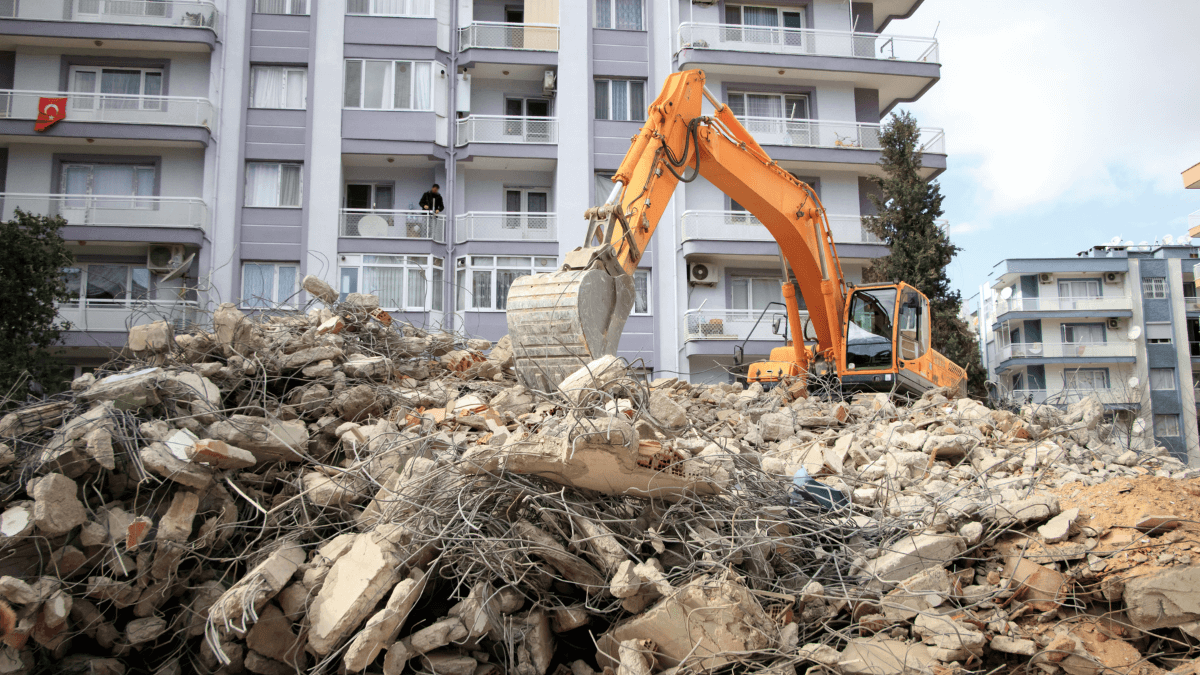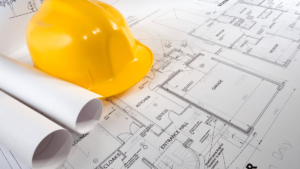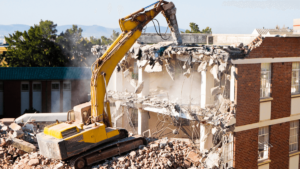Did you know that the construction industry creates more waste than most industries?
In fact, according to statistics, one-third of the world’s overall waste comes from the construction industry.
Unfortunately, the majority of that waste ends up in landfills and has a negative impact on the environment.
If your business produces waste, it’s important that you know how to manage it properly.
To make it easier for you, we’ve made a guide to construction waste disposal.
In this article...
What Types of Materials Count as Construction Waste?
Construction waste is any type of material waste generated during building, demolishing, or renovation.
It includes a variety of materials in the form of building debris, concrete, rubble, timber, etc.
To simplify, we will divide those materials into three main types and briefly explain each one.
Building Materials
We’ll start with building materials.
Some of the most common examples are bricks, metal, cement, wood, nails, tiles, ceramics, glass, insulation material, and wiring.
Believe it or not, up to 30% of all building materials delivered to a construction site end up as waste.
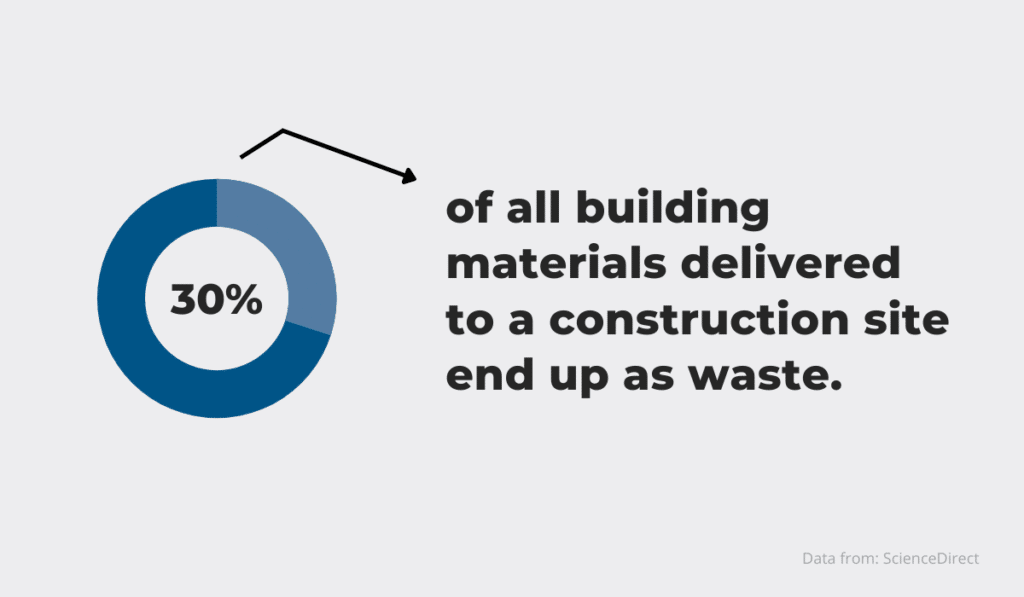
Those materials can end up being thrown away because they got damaged during the building process or the transportation, or if they simply ended up unused.
The good news is that most building materials waste can be recycled, reduced, and reused.
Let’s take bricks as an example.
Brick recycling is a relatively easy process in which bricks are pulverized so that they can be remade into new blocks, ready for use.
Since an average home is made from 10,000—15,000 bricks, you can only imagine how much waste they make.
However, they are easily recyclable; you just need to take them to the appropriate facility.
Hazardous Materials
This type of waste gets produced at construction sites during building, demolition, or restoration.
You can find harmful materials at almost every construction site in the world.
Basically, waste is hazardous if it contains substances harmful to human health and the environment, even if they don’t immediately affect it.
Some of the most common examples are leftover paints, contaminated soil, asbestos, aerosol cans, striping paint, solvent, paint thinners, mercury, fluorescent bulbs, lead, and leftover paints.
Gypsum materials such as drywall can also be categorized as hazardous.
When gypsum is sent to a landfill, it produces hydrogen sulfide gas which is toxic in high concentrations.
This is why some landfills don’t accept drywall.
Therefore, it’s better to dispose of it in specialized facilities, like the one below.

In general, hazardous materials need to be properly disposed of, which is usually regulated by strict laws.
Some of them can be recycled, like fluorescent bulbs and drywall.
Demolition Waste Materials
The vast majority of construction waste comes from demolition.
For instance, in 2018, demolition waste materials accounted for 90% of the 600 million tons of total construction waste in the US.
To put it simply, this type of waste consists of all the debris from a demolition project. It includes building materials such as bricks, tiles, wood, glass, ceramics, and some hazardous materials such as asbestos.
Asbestos exposure is incredibly dangerous since it increases the risk of lung diseases and lung cancer.

Clearly, asbestos needs to be carefully handled and disposed of.
Still, other non-hazardous demolition waste can usually be reused for future projects or recycled—with the exception of certain types of plastic such as Styrofoam, PVC siding, and PEX pipes.
Why Is Construction Waste Management Important?
There are several reasons why construction waste management is important. Let’s start with the basics.
Construction sites are messy, which often negatively affects the workers’ ability to stay productive.
To make it easier for them, you should implement waste management practices from the start of your project.
In this way, order will be maintained, and everyone will stay focused.
Another reason is safety.
Making sure that the waste and debris are disposed of properly will prevent many on-site accidents.
For instance, you can rent a waste disposal container to keep your construction site neat and organized.
Containers like the ones offered by Valley Waste Disposal & Recycling Inc are inexpensive and convenient solutions you can implement in your waste management.

However, care for the environment is the main reason for implementing effective waste disposal practices.
Waste that gets crushed and buried in landfills produces overtime CO2 and methane gas, also known as greenhouse gases. High levels of these gases contribute to climate change.
To reduce those harmful emissions, it’s important to cut down on the waste we send to landfills.
This is where effective construction waste management comes into play since it includes the appropriate handling of non-recyclables that can extend the life of landfills.
When waste is processed or recycled responsibly, negative impacts on the environment are reduced.
The image below shows best practices in construction waste management, and as you can tell, outright disposal is the least favored one.
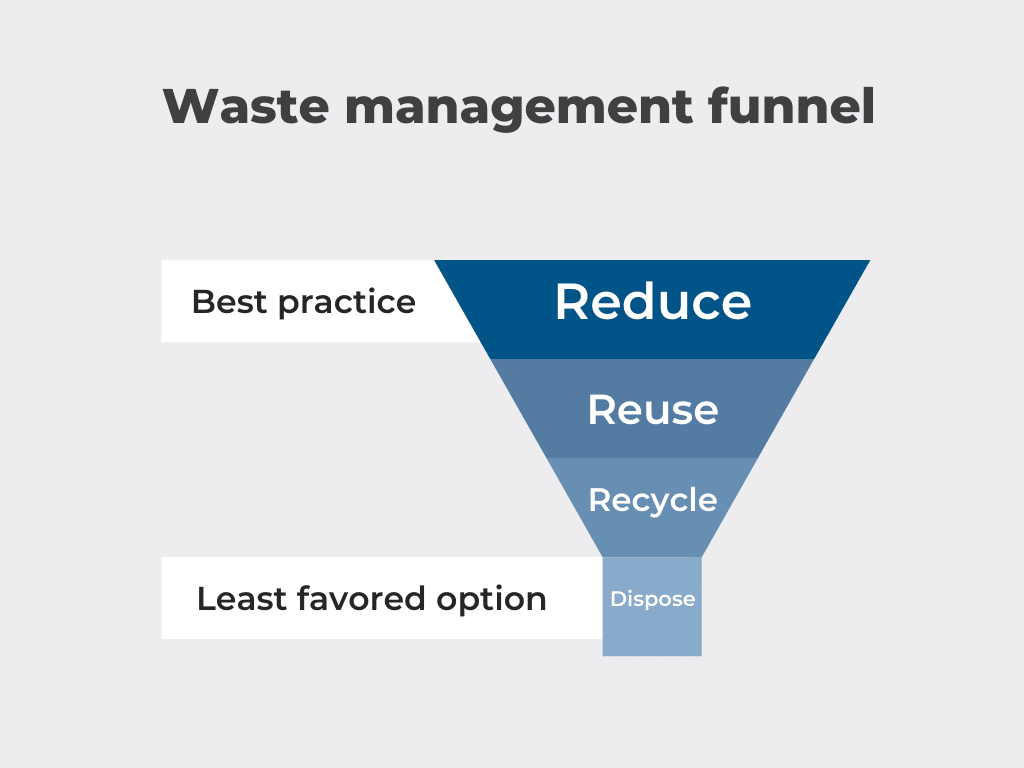
Effective construction waste management is not just good for the environment; it also reduces costs.
Reusing materials reduces spending and prevents double costs (i.e., paying for the materials that go to waste, as well as their disposal).
But another way of approaching this problem is to try to create less waste to begin with.
Let’s look at the example of The Resource Efficient House.
This ground-breaking project illustrates how careful design can help reduce landfill waste.
The construction process produced less than five tonnes of waste, which is a great success if you consider that building an average house results in around 13 tonnes of waste.
Also, the site achieved high overall recycling rates of 96.83%, and best of all, 100% of excavation waste was recycled.

However, many construction companies tend to neglect waste management practices, and it seems that this is due to the fact that they don’t understand the benefits.
For example, a study was done on construction waste management practices by construction firms in Nigeria, where respondents were asked some questions regarding the importance of construction waste management.
As you can see from the table below, the study has shown that there is no completely clear understanding of waste management benefits.

The majority of the respondents saw lower project costs and a cleaner environment as the most important advantages, overlooking the importance of a longer lifespan of materials and increased patronage.
In short, construction waste management aims to protect the environment since the waste from construction and demolition significantly contributes to pollution.
But there are also some other benefits, such as increased on-site safety, better productivity, and reduced costs.
How Are Different Types of Construction Waste Disposed Of?
Now that we’ve discussed the importance of construction waste management, it’s time to look at what exactly the disposal process entails for different types of materials.
Building Waste
Most of the building waste can be recycled, reused or donated to the people who need it.
However, if that’s not an option for you, a simple way to get rid of building waste is to rent a dumpster and take it to the landfill.
This is a solution that’s cheaper and more efficient than relying on service providers for this part of construction work.
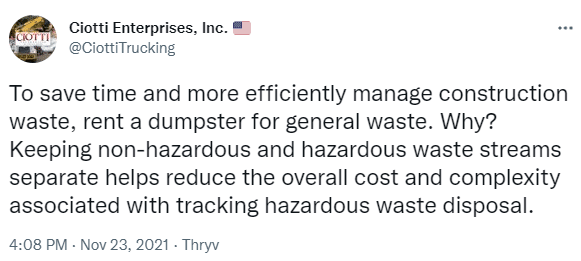
Other options are to hire a local waste removal service to do the job for you or simply have it collected by a waste management company.
Demolition Waste
Similar to building waste, demolition waste can also often be recycled or taken to the landfill using the same methods.

However, it needs to be sorted first since it often contains hazardous materials, primarily asbestos.
We’ve already mentioned the negative effects asbestos can have on human health, so clearly, it needs to be disposed of carefully.
You can dispose of non-regulated asbestos together with other demolition waste in the landfills.
However, if it requires regulation, you’ll need to package it in leak-tight containers and dispose of it on a licensed disposal site.
Since disposing of asbestos can be a complicated process, it’s a good idea to hire licensed professionals to do it for you.
Just make sure that the company you hire follows prescribed rules and regulations.
Hazardous Waste
Same as asbestos, other hazardous waste must be disposed of according to rules and regulations provided by the state.
For instance, lead-based paint and its debris need to be collected in a bag or separated and stored in special containers.
Once you store your hazardous waste away, you need to label it appropriately.
Also, you don’t want to contaminate your construction site, so we recommend using waterproof covers.

The next thing you need to do is contact your waste management company to collect it.
And don’t even think of not following regulations. Illegal waste disposal can result in fines and even jail time.
The maximum penalty for unintentional misleading information regarding waste is 250,000 dollars for a company.
And if the information is supplied knowingly, the fines go as high as 500,000 dollars for a company.
How to Improve Your Construction Waste Disposal Process?
Unfortunately, the most common practice for construction waste management is dumping it in landfills.
As common as this practice is, it’s often expensive. It also results in the wasting of large amounts of materials—and it’s important to emphasize that construction waste is not worthless.
This is why we’ll discuss how you can improve your construction waste disposal process using the three Rs (reduce, reuse and recycle).

So, let’s take a closer look at what you need to do to improve your disposal practices.
Develop a Construction Waste Management Plan
Site waste management plans (SWMPs) are designed to help plan how construction waste will be managed at all stages of a construction project.
E site waste management plan will determine:
- which materials will be used and most likely become waste
- how waste will be handled and stored on-site
- how waste will be disposed of
The process of waste management is conducted in stages, as shown in the image below.
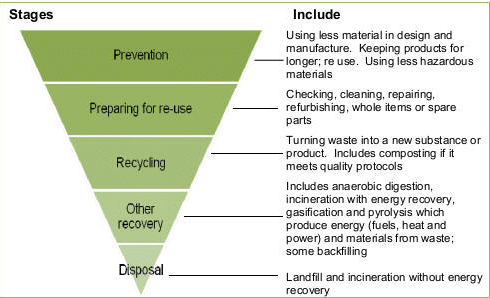
SWMPs are normally created before the construction begins, and once it does, any waste disposal handled on the site is being recorded.
Reports are needed to ensure that waste is disposed of in the most responsible, efficient, and profitable way possible.
Reduce
When it comes to waste, the best option for the environment and for your bank account is to reduce the amount of waste created.
There are several ways to achieve this.
You can, for instance, arrange for your materials to be delivered in alignment with the construction stages of your project.
In this way, you will avoid the pile-up of extra materials in storage and reduce the chances of the materials getting damaged.
Another thing that will help prevent damage is to keep an eye on the weather forecast and secure and protect your materials accordingly.
You can also use technology.
For example, building information modeling (BMI) is a software modeling process that architects, engineers, and contractors use to collaborate on a building’s design and construction.
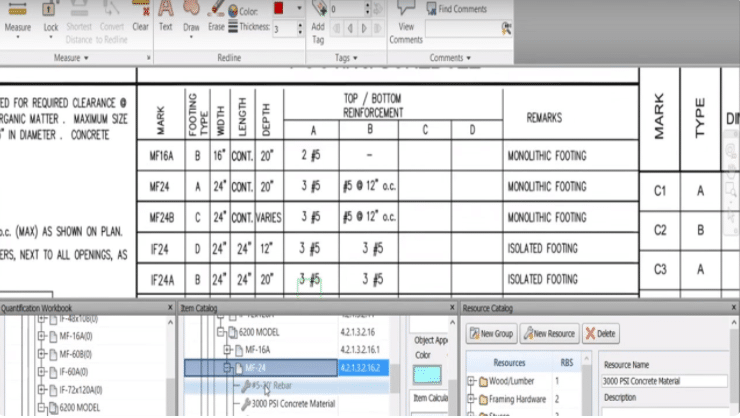
BMI allows the creation of a virtual model that acts as a digital record of all the materials. Thanks to that, contractors get to plan how they can salvage used materials and predict the exact amounts needed to eliminate excess waste.
Reuse
Even if you fail to reduce, don’t worry—you can still reuse many building materials.
Bricks, tiles, ceramics, metal, and other waste in good condition can be used for various things like DIY projects or new construction projects. They can also be donated.
Damaged materials can be crushed and used for building roads or as coarse aggregate for concrete.
A really good example of reuse we can give you is the first second-hand house in Germany, made entirely from reused materials.

It was even avoided to glue elements together so that all the materials could be reused in the future without losing quality.
Interiors were also made entirely from reused materials from demolished buildings. Just take a look at how good these bathroom sinks look.
So, reusing your construction materials is a great solution to save some money and help save the mother earth from pollution.
Recycle
If the waste can’t be reduced or reused, you should recycle it.
Most materials are easily recyclable, as you can see in the table below.
Metal and paper or cardboard are the easiest materials to recycle, followed by concrete, glass, and ceramic tiles.
Gypsum, styrofoam, and mineral wool insulation have recycling potential, but the recycling techniques for these materials are still not fully developed.
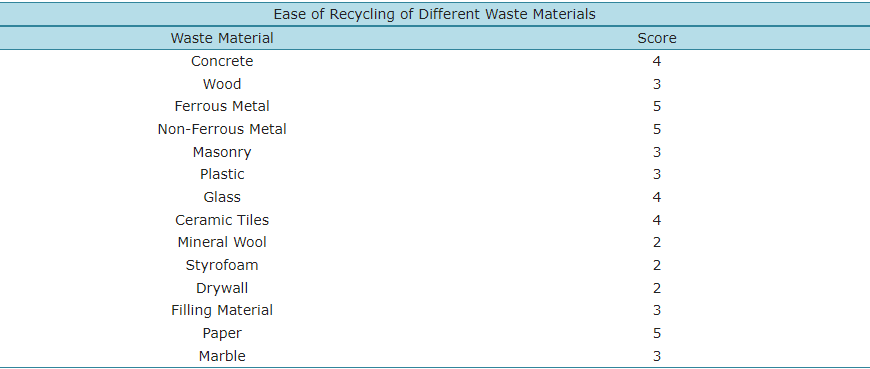
Unfortunately, despite that, the construction industry sends millions of tons of waste to landfills every year.
Still, there are also some positive examples, like the one of a New York construction company CNY Group.
Their CEO Ken Colao said they were able to recycle more than 90% of the waste and surplus material from their construction projects.
“The high rates of recyclability were a result of the company paying close attention to the amount of materials purchased for the projects and making sure to find certified waste haulers that could take recyclable material to certified recycling facilities.”
The key takeaway here is that reducing, reusing and recycling can only bring benefits, both for your company and for the environment.
Conclusion
Construction sites are messy, and having a waste management plan is essential.
Knowing the types of construction waste and how to dispose of each one is undoubtedly a must.
For example, hazardous and non-hazardous materials can’t be disposed of in the same way.
If you follow the advice given in this article, your waste disposal will be efficient, and you will save lots of money. Not to mention you’re also helping to save the planet.
